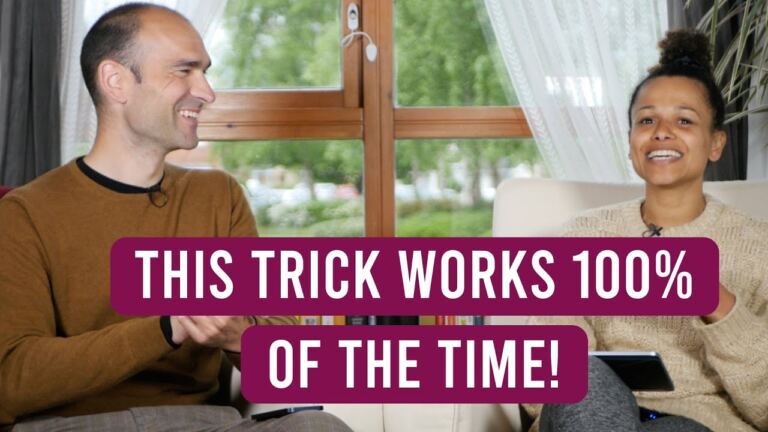Telling & Asking the Time – Portuguese Portugal/European
Whether or not you want to become fluent in Portuguese, learning how to tell and ask the time is essential. Regardless of where you are in Portugal, this skill will help you navigate everything from restaurant reservations to public transportation schedules. The video below will help you explore this aspect of the Portuguese language.
You will see that learning how to tell and ask the time in Portuguese is easier than you think. You need not worry if this is your first lesson. We will keep things clear and simple, using real-life examples. In just 20 minutes, you will learn all about Portuguese time-related vocabulary. You will discover new words, concepts, and sentences. Ready? Let’s get started.
How to Ask the Time in Portuguese
The most common question to ask the time in Portuguese is Que horas são? (What time is it?). You can also ask Tem horas? (Do you have the time?) or Que horas tem? (What time do you have?). All of them are acceptable, but Que horas são? (What time is it?) is the most standard one.
To be more polite, you can add Por favor (Please) after your question and say Obrigado/a (Thank you), when you get the answer. You can use these expressions with strangers, shop assistants, or anyone in public. But it still means the same and sounds natural in informal settings. Thus, you can also say it to your friends and family.
Asking the time also changes according to the period you are referring to. If you want to know for the present moment, you can ask: Que horas são agora? (What time is it now?). Instead, if you want to know what time something will happen, you can say A que horas? (At what time?).
Common Time-related Vocabulary
When you learn a new language, establishing connections between different terms helps you memorize them. Here are 12 Portuguese words related to asking and telling the time in Portuguese.
- Hora/s (Hour/s)
- Minuto/s (Minute/s)
- Tempo (Time)
- Meia (Half Past)
- Em ponto (O’clock)
- Quarto (Quarter)
- Meio dia (Midday)
- Meia noite (Midnight)
- Manhã (Morning)
- Tarde (Afternoon)
- Noite (Night)
Here is how to say all the hours from one to twelve in Portuguese:
- É uma hora (It is one o’clock)
- São duas horas (It is two o’clock)
- São três horas (It is three o’clock)
- São quatro horas (It is four o’clock)
- São cinco horas (It is five o’clock)
- São seis horas (It is six o’clock)
- São sete horas (It is seven o’clock)
- São oito horas (It is eight o’clock)
- São nove horas (It is nine o’clock)
- São dez horas (It is ten o’clock)
- Onze horas (It is eleven o’clock)
- São meio dia/meia noite (It is midday/midnight)
Telling Time in Portuguese
Portuguese natives usually divide the day into three periods and specify which period they are referring to. Hence, you will often hear Da manhã (In the morning), Da tarde (In the afternoon), and Da noite (At night). Despite using military time and a 24-hour clock in writing, they also usually refer to the time in 12-hour periods. Thus, you usually hear É uma da tarde (It is one o’clock in the afternoon) or São três da manhã (It’s three in the morning).
The word Hora (Hour) applies to noon, midnight, and the first hour of the morning and afternoon. All other times, use the plural form Horas (Hours). So, you would say É meio dia (It’s noon), and São sete horas (It’s seven o’clock).
For minutes past the hour, say e (and) plus the minutes. For example, you might say São três e dez (It is ten past three). Conversely, the expression Em ponto means On the dot or O’clock. So you can say São cinco em ponto (It is five o’clock) or São dez e dez em ponto (It’s ten past ten on the dot).
Half past is E meia (And a half). For example, you might hear São quatro e meia (It is half past four). A quarter past is E um quarto (And a quarter). To say it is a quarter past six, you will say: São seis e um quarto.
For minutes to the next hour, use Para (To). For example, you can use São dez para as oito (It is ten to eight), or São cinco para as três (It is five to three). If the difference is fifteen minutes, you say Quinze para (fifteen to) or Um quarto para (a quarter to). Thus, if it is fifteen to midday, you should say São quinze para o meio dia or São um quarto para o meio dia. However, you can always stick to the simple form and say the hour followed by the minutes past.
Writing Practice – Asking and Telling the Time
Here is how a short conversation between two coworkers might go.
— Como dormiste? [How did you sleep?]
— Bem, mas pouco, fui dormir à uma e meia da manhã. E tu? [Well, but little, I went to sleep at one-thirty in the morning. And you?]
— Pois, isso é tarde… Eu dormi bem, às dez para as onze já estava deitada. Ainda vamos almoçar, certo? [Yeah, that’s late… I slept well, at ten to eleven I was already in bed. We’re still going for lunch, right?]
— Claro. Mas a que horas é a hora de almoço? [Sure. But what time is lunch time?]
— Às duas e meia. [At two-thirty.]
— Ok, perfeito. [Ok, perfect.]
The best thing is, you can use the same format for formal and informal Portuguese. In this “Basics of European Portuguese” video, we will learn how to ask for and say the time in European Portuguese. To help you practice, you can check the time aloud in Portuguese throughout the day.
Extra content & tailored exercises related to this basic lesson are available to members of our The Journey program.
Obrigada, Carla
Ready to become fluent in European Portuguese?
For the last decade, we’ve been working on putting together the best possible European Portuguese course. After much research, feedback from our students, and a number of iterations, we think we’ve got it! 😉
As a base, we used scientifically proven techniques to help with master pronunciation, phrase construction, oral understanding, grammar, and all the necessary bits to get you to fluency. At the same time, having learned foreign languages ourselves, we know the process needs to be engaging, varied, and enjoyable. The whole thing is presented as an adventure. It’s a course like no other, trust us!
Learn more about The Journey and start your free trial here.


![TOP 50 most used Verbs by the Portuguese [European Portuguese]](https://portuguesewithcarla.com/wp-content/uploads/2021/10/TOP-50-most-used-Verbs-by-the-Portuguese-European-Portuguese-768x432.jpg)




Tens horas que me digas?
Thank you very much, muito abrigada
Your videos are really important to me and interesting. This is the only way I can learn European portuguese with free access and with sound and pronounciation.
Ioiiii
If one is ii’s
Oookokoooikkoioookiooool
Muito obrigada para o video novo!
Obrigada gosto de tudo
I like it when you don’t have a sound in the background for atmosphere. Like a fake restaurant or music. Such things have value for normal videos, but I’m trying to hear you clearly.The video with the colours for instance has production video, but I am no Kindergarten child…please loose the sound and music in the background. So this kind of video is just GREAT! Keep it up!
I need every day life basics. I’ve been living in Portugal for 10 months but it is so hard to learn. I am barely A2 level. :/
Carla, what’s “Lavender” in European Portuguese?
I see “Lavanda” and “Alfazema”, which one is correct/more common?
Lavender olá 👋🏼 I would say they both correct and as common as each other but I personally prefer to say “lavanda”, but that’s me. Either way you say it, it’s fine 🙂
Actually Lavanda (Lavandula angustifolia) and Alfazema (Lavandula latifólia) are not quite the same plant.
Hi! Your videos are so helpful. Please post more videos
Learning from Bangladesh… Love it
Gratidão Carla, Sucesso para os dois.
oi bomdia . ela is video nice. eu sou o md: Shahed Patawary eu estou bem obrigado e tu?
I love how you teach. Very patiently and clear. Obrigada from California
thank you Carla for sharing, i love your way of teaching:)
Fixe
Obrigada! 🙂
Gostei imenso do conteúdo e da abordagem.
Só useful. I find your explanationsreally easy to understand.
This was great, because you’re hearing (and training) your ear to hear the real rythm-thank you!
Excellent teacher
Thank You 💐
I thought in PT or particularly LIS they prefer the 24hrs format?
Eu sou da região de Lisboa e sempre disse “é um quarto para …” e nunca ouvi “são um quarto para…”. De igual modo ” é uma e meia ” e não ” são uma e meia”.